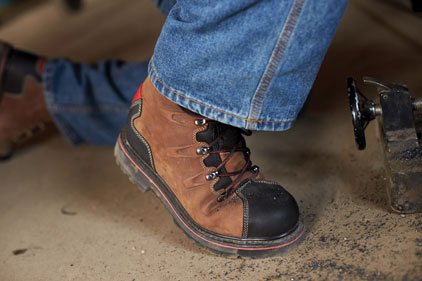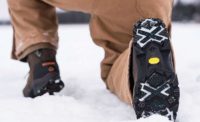Toe protection and metatarsal guards
The American Society for Testing and Materials (ASTM) F2413-11 Standard Specification for Performance Requirements for Protective (Safety) Toe Cap Footwear is the standard safety-toe certification. The standard is usually listed as: ASTM F2413-11 M I/75 C/75
The letter M or F identifies the gender (male or female) for which the footwear is intended. The “I” is for impact resistance (if something heavy were suddenly dropped on the foot) and the number signifies the impact resistance rating (75 foot-pounds). “C” represents compression resistance (if something rolls over or crushes the foot) and the compression resistance rating (75, which represents 2,500 pounds of pressure).
Safety toe caps are available in steel, aluminum alloy, and composite materials. Steel is the most time-tested material. It’s is affordable, strong and few materials can meet or exceed its strength, resilience and elasticity. Caps thermo-formed from resins and fiberglass composites are becoming popular. They offer the same protection as steel and are lighter, do not conduct heat or cold in extreme temperatures, and are non-metallic (making it easier to pass through metal detectors).
Metatarsal guards cover the front of the foot and help prevent or reduce the severity of an injury to the metatarsal and toes. Metatarsal guards are identified as Mt/75, where the rating (75 foot-pounds) is identified.
Other rated components
Other ratings include electrical hazard (EH), conductive (CD) properties, puncture resistance (PR) properties and electric static dissipative (ESD) properties.
EH, or Electrical Hazard, footwear is made with insulative electrical shock resistant outsoles and materials. It provides secondary protection against contact with live electrical circuits and electrical conductors, parts or machinery. Footwear with an EH designation must withstand 18,000 volts at 60 hertz for one minute with no current flow in excess of 1.0 mill amperes, in dry conditions.
Conductive footwear is designed to dissipate static electricity from the body to the ground. The electrical resistance should range from zero to 500,000 ohms. Closely related is static dissipative footwear, which helps reduce an accumulation of static electricity by conducting body charge to the ground.
Puncture resistance must be built into the shoe during the manufacturing process, often with a PR plate that is built into the shoe’s midsole. PR footwear must endure at least a 270 pound force, and also show no sign of cracking after 1.5 million flexes to ensure the protection is long-lasting. If the puncture resistant midsole or insole is metal, it must also pass a corrosion resistant test.
Outsole material
Genuine rubber is the most common material due to that fact that it offers excellent performance in terms of abrasion, oil- and slip-resistant qualities that are needed in a work boot where durability and performance are important.
The main advantage of newer materials like TPU (thermoplastic polyurethane), PU (polyurethane) and EVA (Ethylene-Vinyl-Acetate) is that they are all lighter in weight, more flexible and, in the case of PU and EVA, provide greater cushioning. Many modern work boots offer combinations of these synthetic materials and rubber.
Upper material
Made from man-made fibers and resins, most synthetic materials (including synthetically enhanced leather) are lightweight, durable and can be formulated to be waterproof. Still, leather remains the tried and true upper material in many work boots. Leather is breathable and a good choice for people who are on their feet for many hours at a time. Leather is by nature quite durable, and can be treated with waterproof compounds for additional performance.
Waterproof components
In addition to waterproof uppers, whether it’s leather, synthetic or a combination of the two, there are components that can supplement the waterproof nature of a boot. A waterproof membrane, such as GORE-TEX®, guarantees that feet stay dry in wet environments, while still maintaining breathability.
Insulation
Insulation is an important consideration for people who work in wet and cold environments. Insulation typically ranges from 200 grams for light warmth to 1200 grams for use in the coldest, harshest conditions.
Construction
Goodyear Welt, where the upper and sole are stitched together, is time-tested and durable construction used for more than 100 years. This process allows boots to be re-soled, extending their longevity. The boot’s outsole and midsole can also be cemented permanently to the upper. In Direct-Attach (or Injection) construction, the sole material is permanently and chemically fused or attached to the upper, resulting in a lightweight, durable and flexible type construction, with the added benefit of being watertight.





